Canon 7s Rangefinder Camera
A Description of the Canon 7s Rangefinder Camera 1965-1968
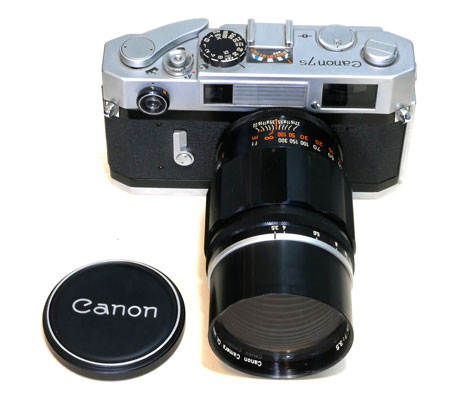
Canon 7s Canon 50mm with 135mm f3.5 telephoto
The Canon 7s Rangefiner 1965-1968
Following the great success of the Canon 7, Canon Camera Co. Inc. engineers designed an improved version which corrected the few deficiencies of the Canon 7. First, the long lamented missing accessory shoe returned to the top of the camera. This was allowed by a more compact light meter read-out with space behind it for the accessory shoe.

Canon 7s top with compact light meter and added accessory shoe
Also, a CdS sensor on the camera front made a more sensitive and accurate light measurement than the large selenium exposure meter on the face of the Canon 7. This exposure meter sensor was surrounded by a ring which selected high or low sensitivity for the light measurement. An important advantage was that the CdS sensor was more selective, more accurate, and did not loose sensitivity with age as did the Canon7 selenium cell. The CdS sensor was powered by a small PX-625 mercury cell located in the camera bottom plate.
The bottom plate also has a locking key which must be turned to allow a release on the side of the camera body to trigger the opening of the camera back. This double mechanism was to prevent accidental exposure of the film by an unintended opening of the camera back.
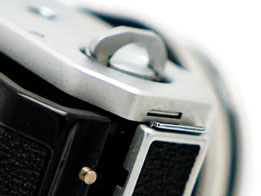
Canon 7s Features
With its launch in February 1985, the Canon 7s was nearly the perfection of interchangeable lens rangefinder cameras, and certainly the finest M39 screw mount rangefinder up to that time. This in the era that the strong trend in the photographic world was to single-lens reflex cameras (of which Canon was also a leader with its series of Canonflex SLR cameras.)
In summer 1967, Canon made further slight changes to the 7s, to which Peter Dechert applied the name "7sZ" 1, although Canon itself did not use such a designation. The "7sZ" principal change was in the improved viewfinder, which featured increased brightness and clarity, and reduced some of the 'ghosts' sometimes seen in the previous viewfinder. This new rangefinder geometry can be detected by observing the 7s top, where the optical adjustment screw has been moved from next to the shutter speed dial to a position just above the viewfinder window in the improved version. Also, the rewind knob of the Canon 7sZ is a larger version taken from the contemporary Canonflex.
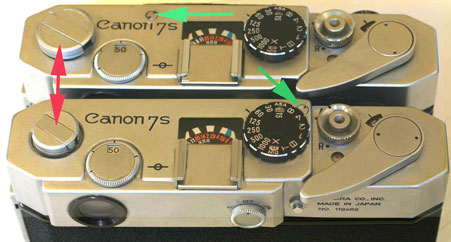
Canon 7sZ top (upper camera) compared with Canon 7s top (lower camera)
In spite of the strong contemporary trend toward single-lens reflex cameras, the 7s sold 16,000 units 1965-1967 and the "7sZ" sold about 4,000 units 1967-1968. 1. The 7s sales compares with the sales numbers of the Nikon SP which is estimated at 22,000 units.
Amazingly, the Canon 7 and 7s cameras sold more units than all of the rangefinder cameras produced by Nikon from its first rangefiner until Nikon's discontinuation of rangefinder production in 1959. 6
1965 Canon Lenses
With the superb Canon 7s, Canon also offered and extensive range of modern lenses, and where necessary with associated finders, as can be seen below.
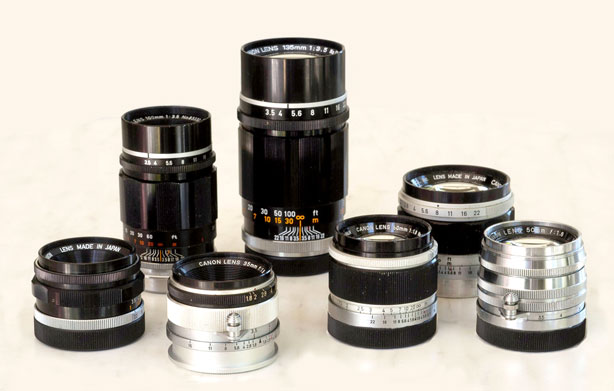
The Canon lenses of the early 1960s (l to r):
Canon 35mm f2.0, 100mm f3.5, 35mm f1.8, 135mm f3.5, 50mm f1.8,
the excellent 50mm f1.4, and the solid chrome 50mm f1.5
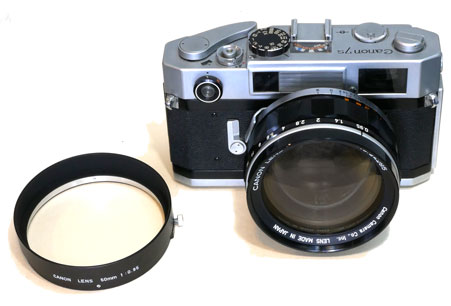
Canon 7s with the massive 50mm f0.95 and its custom hood
all the accessories for the Canon 7s, such as the custom hood were packaged in beautiful black leather cases
Canon 7s Accessories
The leather packaging of the 50mm f0.95 lens hood was not alone. Canon promoted a full range of accessories, as shown in the Canon 7s brochure page, below.
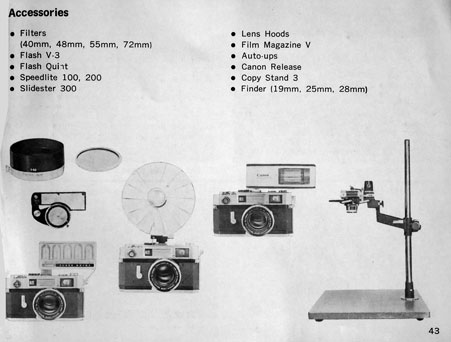
You can read about the many interesting Canon accessories for its line of rangefinder cameras in another page of this canonrangefinder.org site: Canon Accesories. Also, the other Canon rangefinder cameras and lenses leading up to the great (and final) Canon rangefinder 7s are described by clicking on the lins below.
You can click on the links in the table below to consult other pages of the canonrangfinder.org site.
| Navigation: Click Below to Jump to Desired Subject Page | ||
|---|---|---|
| Canon Rangefinder Cameras - 1 | Canon Rangefinder Cameras - 2 | Canon Rangefinder Lenses |
| Canon S | Canon IVSB2 | Canon 19mm |
| Canon J | Canon IIS2, IID2, IIF2 | Canon 25mm |
| Canon NS | Canon VT, Canon L2 | Canon 28mm |
| Canon JS | Canon L1, L3 | Canon 35mm |
| Canon J-II | Canon VT Deluxe | Nikkor 50mm |
| Canon S-II | Canon VL, VL2 | Canon 50mm |
| Canon IIB | Canon VI-L, VI-T | Canon 85mm |
| Canon III, IIC, IV | Canon P | Canon 100mm |
| Canon IIIA, IVF, IVS | Canon 7 | Canon 135mm |
| Canon IIA, IID, IID1 | Canon 7s | Canon 200mm-1000mm |
| Canon IVSB | Minolta Rangefinders | Minolta Lenses |
| Canon IIF, IIS | Other Rangefinders | other M39 lenses |
| Go to canonrangefinder.com home page | ||
Any additions or corrections to these pages would be welcome simply by contacting this site as shown at the foot of this page .
Footnotes:
1 Dechert, Peter. Canon Rangefinder Cameras 1933-1968. Hove Collectors Books. West Sussex, United Kingdom. 1985. ISBN 0-906447-30-5.
Peter Dechert's book is the most important expert source of information regarding Canon Rangefinder Cameras.
2 Kitchingman, Peter. Canon M39 Rangefinder Lenses 1939-1971. A Collector's Guide. Published by Peter Kitchingman. Perth, Australia. 2008. ISBN 978-0-646-48144-9.
Peter Kitchingman's book is the definitive study of the more than three decades of M39 format camera lenses developed for Canon Rangefinder Cameras.
3 Nostalgic Canon Camera Book. 懐かしいキヤノン EI Publishing Co. Ltd. Tokyo, Japan. June 2003.
Peter Kitchingman's book is the definitive study of the more than three decades of M39 format camera lenses developed for Canon Rangefinder Cameras.
4 "Canon Camera Museum" history website. https://global.canon/en/c-museum/history/ published by Canon, Inc. accessed in 2019.
5 Rajner, Hans P. (author), John Wade (editor). Leica Copies. Classic Collections Publications. London, UK. ISBN 13: 9781874485056
Hans P. Rajner's book is an excellently detailed and carefully researched study of camera from around the world which used the Leica M39 lens mount and the same lens to film plane distance.
7 Dechert, Peter. Canon Single Lens Reflex Cameras 1959-1991. Historical Camera Publications. Yakima, Washington. 1992. ISBN 1-879561-04-2.
8 Tomlinson, Shawn M. The Film Photography Book. Lulu Pulbications. 2016. ISBN: 9781365263972
9 Sartorius, Ghester. Identifying Leica Lenses. Classic Camera 19. Tokyo, Japan. 2001. ISBN 4-257-12029-0
10 website http://www.nicovandijk.net/rflensmatrix.htm consulted 2019.
11 O'Reagan, Douglas M. Allied Exploitation of German Science after World War II. Johns Hopkins University Press. Baltimore, Maryland. 2019. ISBN 9781421428888
12 website www.canonrangefinder.servehttp.com consulted 2008.
13 Minolta expert Andrea Aprà has posted information on minoltarangefinders group and other groups and further detailed information by email. (thanks Andrea !)
14 website http://www.collection-appareils.fr/objectifs/ consulted 2019.
15 Small, Marc James. Non-Leitz Leica Thread-Mount Lenses. Wittig Books. Hückelhoven, Germany. 1997. ISBN 3-930359-47-2.
16 the Nikon Corporation website: https://imaging.nikon.com/history/ consulted 2019.
17 p 152. Ray, Sidney F. Photographic Lens ISBN 9780240510323
18 website http://www.rokkorfiles.com/Lens%20History.html accessed 2019
If you have any comments or questions about this Canon Rangefinder site, please e-mail me (Larry Huffman) at e-mail address: [email protected]